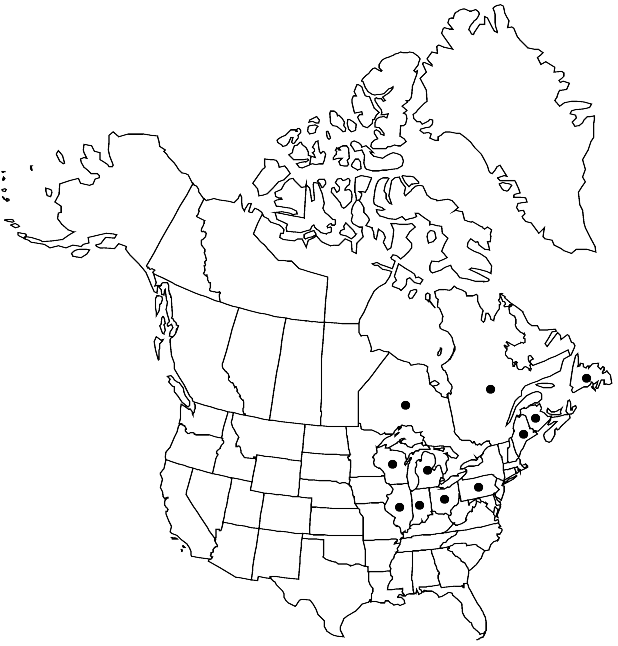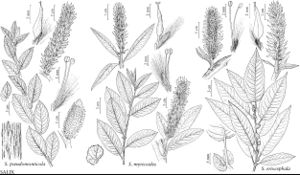Difference between revisions of "Salix myricoides"
Ges. Naturf. Freunde Berlin Neue Schriften 4: 235, plate 6, fig. 2. 1803.
FNA>Volume Importer |
imported>Volume Importer |
||
| (2 intermediate revisions by 2 users not shown) | |||
| Line 8: | Line 8: | ||
}} | }} | ||
|common_names=Blue-leaf willow | |common_names=Blue-leaf willow | ||
| + | |special_status={{Treatment/ID/Special_status | ||
| + | |code=F | ||
| + | |label=Illustrated | ||
| + | }}{{Treatment/ID/Special_status | ||
| + | |code=E | ||
| + | |label=Endemic | ||
| + | }} | ||
|basionyms= | |basionyms= | ||
|synonyms={{Treatment/ID/Synonym | |synonyms={{Treatment/ID/Synonym | ||
| Line 69: | Line 76: | ||
|publication title=Ges. Naturf. Freunde Berlin Neue Schriften | |publication title=Ges. Naturf. Freunde Berlin Neue Schriften | ||
|publication year=1803 | |publication year=1803 | ||
| − | |special status= | + | |special status=Illustrated;Endemic |
| − | |source xml=https:// | + | |source xml=https://bitbucket.org/aafc-mbb/fna-data-curation/src/2e0870ddd59836b60bcf96646a41e87ea5a5943a/coarse_grained_fna_xml/V7/V7_122.xml |
|genus=Salix | |genus=Salix | ||
|subgenus=Salix subg. Vetrix | |subgenus=Salix subg. Vetrix | ||
Latest revision as of 22:30, 5 November 2020
Plants 0.3–5 m, (sometimes forming clones by stem fragmentation or layering). Stems: branches (sometimes highly brittle at base), red-brown or yellow-brown, not or weakly glaucous, (slightly or highly glossy), glabrous or villous; branchlets red-brown or yellow-brown, glabrous or sparsely to very densely villous, (buds caprea-type, inner membranaceous bud-scale layer free and separating or not). Leaves: stipules rudimentary or foliaceous on early ones, foliaceous on late ones, apex acute or acuminate; petiole shallowly grooved, or convex to flat adaxially, 3.5–7.3–13 mm, (sometimes with 2 spherical glands distally), villous, tomentose, pilose, or pubescent adaxially; largest medial blade narrowly oblong, narrowly elliptic, elliptic, or oblanceolate, 35–61.3–110 × 11–16–46 mm, 2–2.7–5.2 times as long as wide, base convex, rounded, subcordate, or cuneate, margins flat or slightly revolute, (thickened and raised), crenulate or serrulate, apex acuminate, acute, or convex, abaxial surface usually very thickly glaucous, glabrous or pilose, midribs pubescent to tomentose, hairs (white, often also ferruginous), curved, wavy, or straight, adaxial slightly glossy, glabrous or pilose, midribs sparsely pubescent (hairs white, sometimes also ferruginous); proximal blade margins entire or serrulate; juvenile blade translucent, reddish or yellowish green, glabrous or sparsely pubescent abaxially, midribs often densely hairy, hairs white, sometimes also ferruginous. Catkins: staminate flowering before leaves emerge, pistillate as leaves emerge; staminate stout or slender, 23.5–35.6–51 × 9–12.7–22 mm, flowering branchlet 1–3.9–10 mm; pistillate loosely flowered, stout or slender, 19–42–62(–85 in fruit) × 8–13–18 mm, flowering branchlet 1.5–5.9–13 mm; floral bract brown or bicolor, 1.2–1.8–3 mm, apex rounded or acute, sometimes toothed, abaxially hairy, hairs straight or wavy. Staminate flowers: adaxial nectary narrowly oblong, oblong, square, or ovate, 0.44–0.48–1.4 mm; filaments distinct, glabrous; anthers yellow, (ellipsoid or globose), 0.52–0.69–0.76 mm. Pistillate flowers: adaxial nectary oblong, narrowly oblong, square, or flask-shaped, 0.56–0.8–1.4 mm, shorter than stipe; stipe 0.96–1.7–3.4 mm; ovary pyriform, glabrous, beak slightly bulged below styles; ovules 12–14 per ovary; styles (sometimes distinct), 0.3–0.8–1.3 mm; stigmas flat, abaxially non-papillate with rounded or pointed tip, or slenderly cylindrical, 0.24–0.43–0.56 mm. Capsules 5–7–11 mm.
Phenology: Flowering early Apr-early Jul.
Habitat: Stream and lake shores, gravel bars, subalpine conifer forests, alkaline fens, sea cliffs, dry limestone talus, swamps, tidal meadows, sand dunes
Elevation: 0-1100 m
Distribution

N.B., Nfld. and Labr. (Nfld.), Ont., Que., Ill., Ind., Maine, Mich., Ohio, Pa., Wis.
Discussion
Plants with densely villous branchlets and branches have been named var. albovestita. Branchlet indumentum varies widely in the species and seems to be continuous, with both villous and glabrous variants sometimes occurring in the same area. This characteristic is more common in populations on the shores of the Great Lakes and on the western coast of James Bay, but even these populations are variable.
Reports of Salix myricoides from Akimiski Island, Nunavut, were based on misidentified S. planifolia. See 68. S. eriocephala for differences.
Hybrids:
Salix myricoides forms natural hybrids with S. bebbiana, S. discolor, and S. glauca var. cordifolia. Hybrids with S. eriocephala have been reported (M. L. Fernald 1950) but no convincing specimens have been seen. Inasmuch as S. eriocephala and S. myricoides are very similar, hybrids between the two would be very difficult to identify.
Selected References
None.
